What Can We Learn From These Social Proof Examples?
Social proof is often mentioned in the marketing world. But how does this psychological phenomenon support your brand’s growth in the ecommerce world? Take a look at these social proof examples to see how these are linked.
Written By
Mia Willmott

Social proof litters the internet and affects how we shop online – whether we are aware of this or not. In this article, we’ll look at what social proof is, and what we can learn from some creative social proof examples.
What is social proof?
How we behave is linked to what we observe of other people.
This link was first documented by Robert Cialdini in his book Influence, published in 1984. Cialdini recognised a psychological phenomenon whereby we mimic the behaviour of others through observation. He coined the phenomenon ‘social proof’, which has since become a concept underpinning all facets of marketing.
When it comes to the ecommerce world, it’s important to remember that users can’t mimic what they don’t see. In other words, users need to be shown what others are doing on your store if you want to leverage the benefits of social proof; to use this herd mentality to your advantage.
To demonstrate the power of social proof in ecommerce, take a minute to consider an example from Amazon. You’re looking for a new kitchen knife. There are two knives that you’re interested in: they are both within your budget, the reviews are positive and both have 4.5 star ratings.
However, one knife has 2,931 reviews and the other has 104 reviews – which product are you more likely to choose? You, and the majority of other shoppers, are more likely to choose the product with a greater number of reviews. This is because of social proof.
Types of social proof
Before going any further let’s first establish the different types of social proof that exist:
- Testimonials
- Influencer or celebrity endorsement
- Third-party reviews
- User-generated content (UGC)
- Ratings
- Reviews
- Number of product users
- Social media followers
- Email subscribers
- Third-party coverage
Most ecommerce sites won’t use all of these, but will instead combine a few. This combination will vary depending on brand style, your goals, and site testing – using A/B testing to identify combinations that increase conversion rates.
Social proof examples and their key takeaways
We’ve already considered a social proof example from Amazon, but what about other examples? How have brands used social proof in creative ways to engage new and existing customers? And, most importantly, what can we learn from these examples?
GoPro’s UGC success
GoPro paved the way for affordable action cameras. They’ve been copied by many, but never been knocked from the top spot. Why is this?
It’s primarily because they have always created an excellent product. But it’s also down to how they’ve proven the excellence of this product. This proof has been achieved by the premium they’ve placed on top-tier social proof since launching in 2002.
For GoPro this has looked like sharing customer content, both videos and photos, taken on GoPro products. This type of content is known as user-generated content (UGC) and is a key component of social proof.
The social proof example that we’ll look at here is GoPro’s Million Dollar Challenge, which launched in 2018 and has run every year since. This is a challenge where customers are encouraged to ‘shoot for your share of $1 million’. GoPro chooses the best video clips from submissions and compiles them into a highlight video. These videos gain millions of views across GoPro’s social channels.
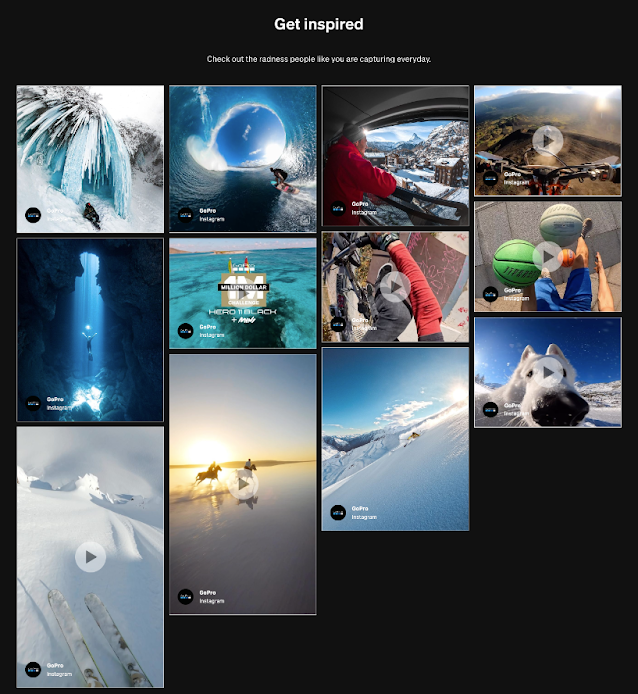
The Million Dollar Challenge demonstrates the lengths that GoPro will go to for high-quality user-generated content; it demonstrates how worthwhile this strategy can be.
This is because UGC – especially video content – puts customers at the centre of a brand, not your product. It shows customers the value your product can bring to their lives; it enables you to engage with their emotions and their sense of purpose – a proven method to drive sales.
Tips to take away:
- Prioritise the collection and display of video content from your customers.
- Think of fun and unique ways to capture UGC. Could you incorporate it into a competition like GoPro? Perhaps you could offer incentives in return for customers sending you their videos?
Daysoft’s rave reviews displayed at multiple touch points
As seen in our example from Amazon, product reviews from other customers play an important role in social proof. This is because reviews share with potential customers the experience that previous customers have had with a brand. Reviews come in different forms and Swanky client, Daysoft, has harnessed them expertly.
Customers can be wary of review sections because brands can use them to only present positive customer feedback and share false reviews. There are two ways to combat this and build trust: offsite reviews and verified buyer reviews.
Firstly, Trustpilot has established itself as the go-to offsite, external review source. It prides itself on offering customers a platform to share authentic reviews, with no interference from brands themselves. These reviews can be integrated with your ecommerce store, where they can be read by potential customers.
Another option is to share reviews from verified buyers. This is what Daysoft has done – harnessing the power of Yotpo to do so. They provide a link to these verified reviews just below the fold on their homepage, thus promoting themselves as a credible store.
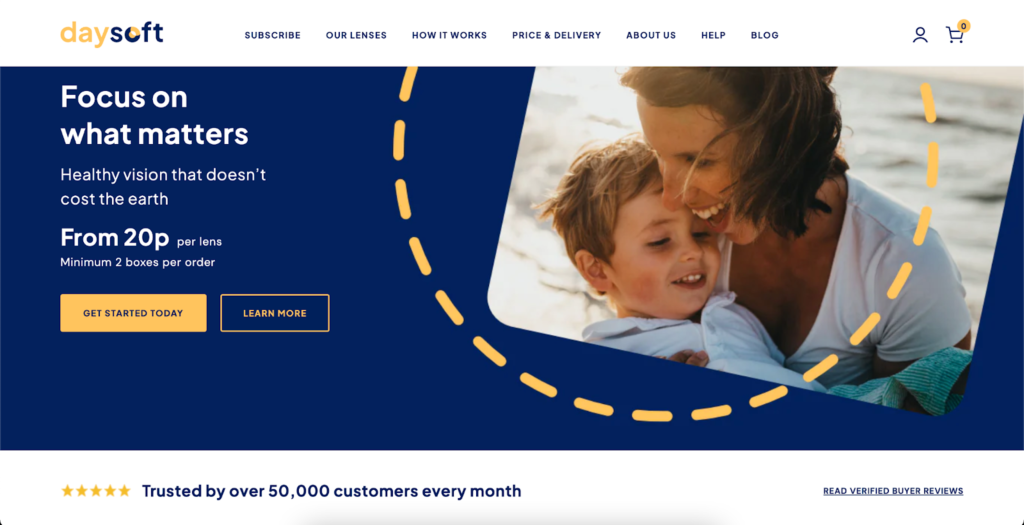
Furthermore, they share longer reviews from satisfied customers on their homepage and throughout their store. These longer form reviews serve the purpose of providing more information about customers’ experiences with the Daysoft products, helping to quell any potential concerns of would-be customers and boost their confidence.
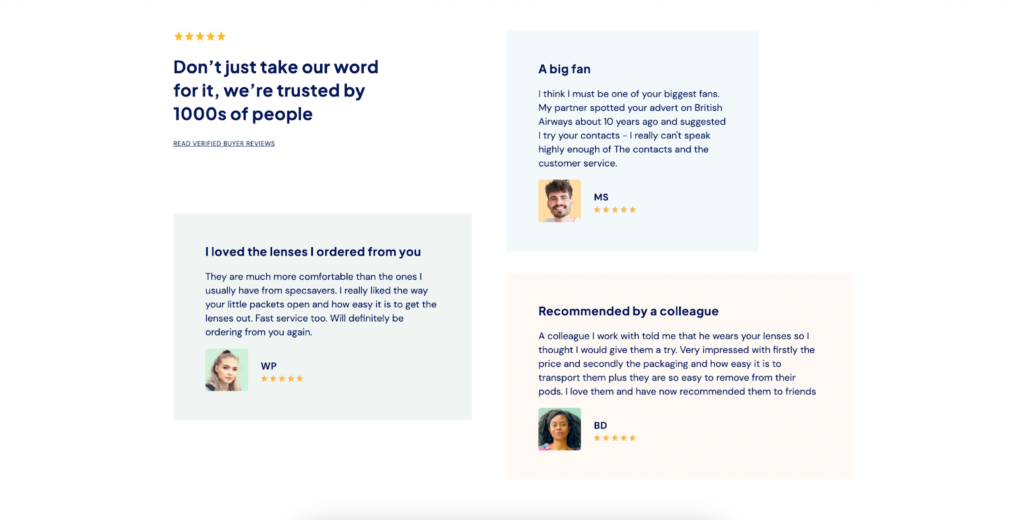
Building confidence like this is particularly key for a health and wellness ecommerce brand like Daysoft, especially one offering a subscription service where customers will be signing up for a repeat purchase.
Tips to take away:
- Reviews offer prospective customers the opportunity to learn more about your product from a user’s perspective.
- Reviews carry more weight when they are from verified buyers or an external review platform.
- Display reviews at multiple touch points in the onsite customer journey for maximum impact.
Triangl influence the influencers: Kendall Jenner
When Triangl first launched, they knew that if they wanted to break into the swimwear industry then they needed to garner support from influencers and leverage the power of celebrity endorsements. At the time, around 2013, this meant gaining the backing of Kendall Jenner – media personality, Instagram sensation and key figure in the Kardashian/Jenner dynasty.
Triangl co-founder Erin Deering talks about how the brand prioritised giving their products to influencers for free and not demanding any promotion in return. She states that 95% of the time, these individuals would post about the products because they liked them so much.1
This was the start of Triangl’s influencer journey. However, the brand wasn’t able to talk directly to Kendall Jenner about a collaboration because they were relatively unknown. To combat this, Deering notes that they sent products to a handful of Jenner’s friends – including Hailey Bieber, Bella Hadid and Gigi Hadid, all of whom had small followings in 2013.
The hope was that Kendall Jenner would see her friends wearing and enjoying Triangl’s swimwear and want to try them out herself.
It worked.
Deering woke up one day to an email from Jenner asking to try out some Triangl swimwear because all her friends were wearing it. Needless to say, when Jenner was seen wearing Triangl, the brand saw an increase in PR and sales.
Triangl managed to strategically leverage the use of social proof to intrigue an individual and elicit a response from them. This is a unique example of using the psychology of social proof in order to gain social proof.
Tips to take away:
- Influencer endorsements are worth pursuing. It may take time to build momentum for these partnerships and endorsements, but the long-term impact of influencer marketing can be hugely positive for your brand.
- Approaching influencer endorsements strategically and creatively is key to success; ensure you are targeting the right influencers, with the right product(s), in the right way.
LiquorLoot serve up social proof and whisky subscriptions
Sydney-based brand LiquorLoot (formerly known as WhiskyLoot) worked with the Swanky Australia team to create a Shopify Plus site ready to scale the brand to new heights. A key component of this site build was developing a custom ecommerce subscription solution to support the brand as it grows.
Another tool the ecommerce site uses is social proof. And it does so with skill.
A prime example is the use of third-party endorsements above the fold on the homepage. These show short quotes from media channels supporting LiquorLoot, along with these outlets’ easily recognisable logos.
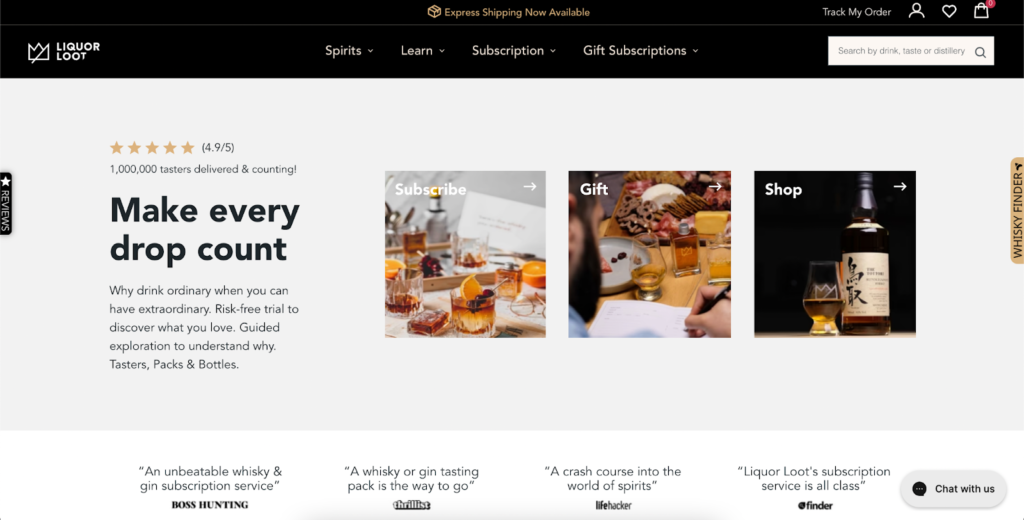
Placing media logos on your homepage like this can be a particularly powerful tactic that immediately makes an impact with site visitors. By aligning your brand with well-known, reputable companies, you can quickly convey credibility and boost confidence.
In this same space above the fold, the user is presented with a 4.9 star rating, and the number of ‘tasters’, or products, delivered.
This first glimpse of the homepage demonstrates how LiquorLoot is using the wisdom of the crowd to encourage other users to trust them and make a purchase.
Tips to take away:
- Focus on endorsements of brands that align with your industry and are relevant to your target market for maximum impact.
- Show third-party endorsements clearly and early on in the customer journey.
- Pair quotes with logos to aid recognition.
Bouclème’s curly hair challenge that encourage transformation photos
Bouclème is a Swanky client redefining the curly hair market. They also share UGC in a strategic way that maximises appeal of their products and nudges customers through the purchase funnel.
They run a 30 Day Challenge designed to offer customers the chance to try their products and see the results for themselves. A campaign like this lends itself perfectly to before and after shots. Not only do these sorts of transformation photos develop customers’ understanding of your products and clearly showcase their benefits, they can create a sense of FOMO. They can be much more compelling than written reviews alone, and are therefore regularly used by beauty and cosmetics ecommerce brands to help drive conversions.
UGC like this can be hugely beneficial to share on your website and social channels. Bouclème leverage it across their social media channels – from TikTok to Instagram – as well as at various points on their ecommerce store, as you can see in the snapshot below
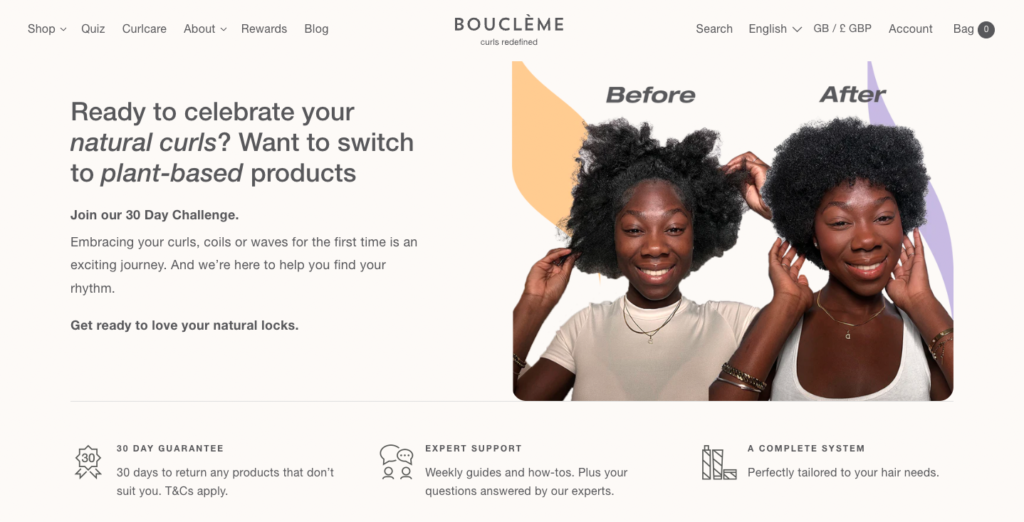
Learn more about Swanky’s ecommerce website design and development work with Bouclème.
Tips to take away:
- Creating a campaign that encourages users to share photos and videos of their transformational experience with your product(s) is a great way to generate UGC.
- UGC can be used across social channels and an ecommerce store; it shouldn’t be limited to one touchpoint, but should be inserted throughout a customer journey.
How will you use social proof?
Given the psychological power that social proof holds, how can you use it for your ecommerce store? There’s no doubt that it’s important, but tapping into the right form of social proof is equally important and takes time to refine.
If you want some advice on integrating social proof to grow your brand, get in touch today to learn about collaborating with our expert growth strategists.
For reference:
[1] https://www.forbes.com.au/news/entrepreneurs/erin-deering-co-founded-a-45-million-business-heres-how-she-knew-when-to-walk-away-from-it/#:~:text=Today%2C

